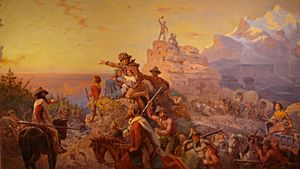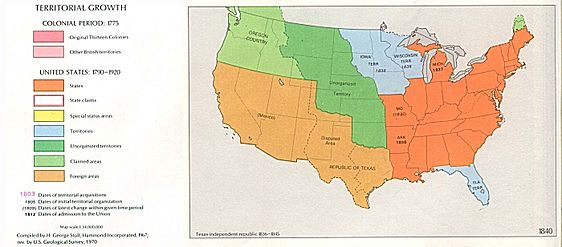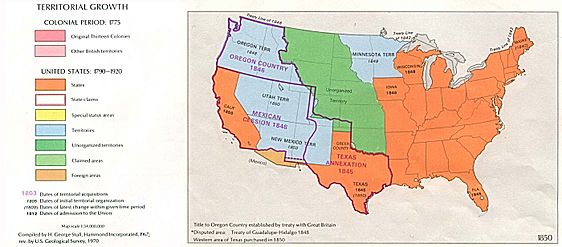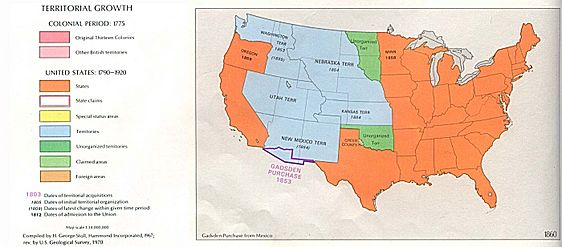Manifest Destiny facts for kids
Manifest Destiny was a popular idea in the United States during the 1800s. It was the belief that America had a special, God-given right to expand and take control of all of North America. The phrase "Manifest Destiny" was first used in 1845 by a newspaper writer named John L. O'Sullivan. This idea quickly became very popular across the country.
Contents
What Was Manifest Destiny?
The idea of Manifest Destiny told Americans they had a special "mission." This mission was to make the United States bigger. The goal was to spread "freedom" to more people. People believed that only Americans could teach others how to govern themselves and live freely.
President James Polk and Expansion
In 1845, James K. Polk became President. Polk strongly believed in Manifest Destiny. During his time as President, the United States grew by a million square miles.
The Mexican-American War
Even before he was President, Polk wanted the land that is now Texas. At that time, Mexico controlled this area.
In June 1845, the United States decided to add Texas. President Polk sent the U.S. military to take over the land. The two sides fought for two years. Finally, Mexico surrendered.
On February 2, 1848, Mexico signed the Treaty of Guadalupe Hidalgo. This treaty ended the war. It also gave the United States all the land north of the Rio Grande. This meant the U.S. gained all of Texas, Arizona, and New Mexico. It also got parts of Utah, Nevada, and Colorado, plus northern California.
Belief in Manifest Destiny helped Americans support the war. It made them feel it was right to fight and take land from Mexicans. They believed they were doing what God wanted. They were doing what they were destined to do.
Moving West: Settling New Lands
The idea of Manifest Destiny also encouraged people to move to other parts of the west. This included places like Oregon and southern California.
How the Country Grew
Many things made people want the United States to grow. More and more people were coming to America. Cities were getting crowded. People wanted their own land instead of working for others. The more land a person owned, the more money they could make. Owning land meant working for yourself and being free.
All these reasons, combined with Manifest Destiny, helped the United States grow quickly in just 40 years:
- Hover over each photo to view its label. Click on the picture to make it bigger.
-
Map of the United States in 1840 (before "Manifest Destiny")
Challenges and Consequences
The United States was very determined to control all of North America. However, the lands they wanted were not empty. These were places where Native Americans had lived for a very long time.
The U.S. government wanted these tribes to move. They wanted them to go to what is now Oklahoma. The government convinced some Native American tribes to sign treaties agreeing to leave their lands.
When some tribes refused to leave, the U.S. government forced them out. This is called an ethnic cleansing. It means a group is forced to leave an area by a more powerful group. When the Cherokee Nation refused to leave their homes, President Martin Van Buren ordered the military to make them go.
About 15,000 Cherokee people were forced to walk to Oklahoma and Arkansas. Most historians believe about 4,000 of them died on the way. This was one out of every four Cherokee people. Because so many people died, this forced migration is now known as the Trail of Tears. It is remembered as a sad and difficult time in American history.
Images for kids
-
American Progress (1872) by John Gast shows the idea of westward expansion. Columbia, a symbol of the United States, leads settlers west. She brings light, strings telegraph wires, and holds a book.
-
John Quincy Adams, painted in 1816 by Charles Robert Leslie. He first supported expansion but later regretted his role in spreading slavery. He became a strong opponent of adding Texas.
-
The first Fort Laramie before 1840. Painting by Alfred Jacob Miller.
-
American westward expansion is shown in Emanuel Leutze's painting Westward the Course of Empire Takes Its Way (1861). The title comes from a 1726 poem. It showed a common belief that civilization always moved west.
-
Filibuster William Walker. He led trips to Mexico and Central America, ruled Nicaragua, and was later executed in Honduras.
-
A newspaper reporting the annexation of the Republic of Hawaii in 1898.
-
A cartoon of Uncle Sam looking at a menu with "Cuba steak," "Porto Rico pig," the "Philippine Islands," and the "Sandwich Islands" (Hawaii).
-
A cartoon about the U.S. wanting to influence the area, especially for the Panama Canal. This led to separation of Panama from Colombia in 1903.
See also
 In Spanish: Doctrina del destino manifiesto para niños
In Spanish: Doctrina del destino manifiesto para niños




















